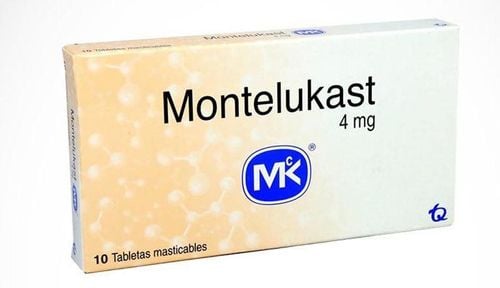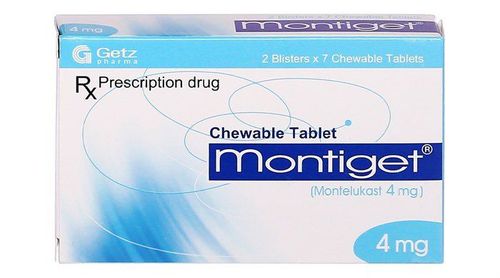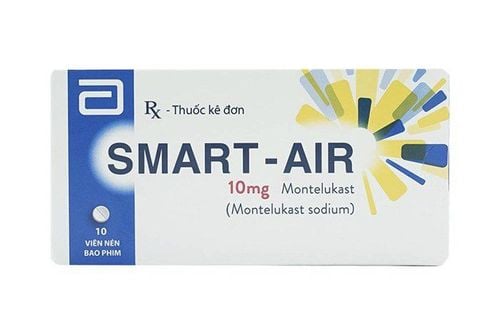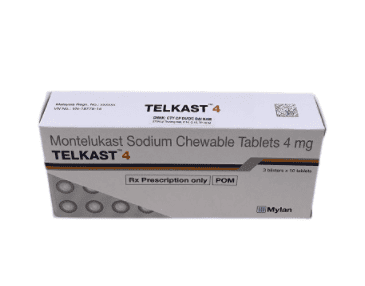This is an automatically translated article.
Miowan 5 is indicated in the supportive treatment of chronic asthma, seasonal allergic rhinitis,... So how to use Miowan 5? What precautions should be taken when using this drug? Let's find out the necessary information about Miowan 5 drug through the article below.
1. Uses of Miowan 5
Indications
The drug is indicated for the adjunctive treatment of chronic asthma in patients with moderate to mild asthma who have not responded well to inhaled corticosteroid therapy. inhalation and is indicated for the treatment of patients whose rapidly acting β-agonists as needed have not responded well to asthma therapy. Symptomatic relief in patients with seasonal allergic rhinitis. The drug is indicated for use in the prevention of symptoms of narrowing of the airways caused by exercise. Dosage - How to use
How to use:
The drug is taken orally. Tablets should be chewed while in use.
Dosage: Recommended dose:
Children ≥ 15 years old: 1 tablet 10mg/day. Children 6-14 years old: 1 tablet 5mg/day. Note:
The medication should be continued even if the asthma attack is under control and during more severe asthma episodes. In prophylactic treatment: it is necessary to evaluate the results after 2-4 weeks of treatment, if the drug does not respond satisfactorily, consider an additional treatment option or another treatment option. In adjunctive therapy: Bloktiene should not be abrupt replacement of inhaled corticosteroids. To treat asthma, it is recommended to take the medicine in the evening. With allergic rhinitis, the duration of medication depends on the needs of each patient. For patients with both asthma and allergic rhinitis, it is recommended to take 1 tablet per day in the evening. Patients 15 years of age and older with asthma and/or allergic rhinitis: 1 tablet of 10 mg or 2 tablets of 5 mg daily. Children 6 to 14 years of age with asthma and/or allergic rhinitis: 1 tablet of 5 mg daily. Children 2 to 5 years old with asthma and/or allergic rhinitis: 1 tablet 4 mg daily. Children 6 months to 2 years of age with asthma and/or year-round allergic rhinitis: 1 tablet 4 mg daily. General recommendation:
The therapeutic effect of Montelukast on asthma test parameters is achieved within 1 day. Patients should be advised to continue taking Montelukast even though their asthma is under control, as well as during periods of worsening asthma. No dose adjustment is required for patients with renal impairment, mild and moderate hepatic impairment, the elderly, or for individual sex. Treatment in relation to other asthma medications:
Montelukast can be used in combination with patients on other treatment regimens. Reduce dose of combination drugs: bronchodilators, inhaled or oral corticosteroids. Montelukast should not be abruptly substituted for inhaled or oral corticosteroids.
2. Side effects of Miowan 5
Disorders of the nervous system: Headache. Stomach and intestinal disorders: abdominal pain, diarrhea, dry mouth, dyspepsia, nausea, vomiting. Blood and lymphatic system disorders: increased bleeding. Immune system disorders: hypersensitivity reactions including anaphylaxis, eosinophilic infiltration of the liver. Psychiatric disorders: dream abnormalities including nightmares, hallucinations, insomnia, agitation, anxiety, hyperactivity, agitation including aggressive behavior, tremor, depression. Nervous system disorders: dizziness, somnolence, paresthesia/hypoesthesia, seizures. Cardiac disorders: palpitations. Respiratory, thoracic and mediastinal disorders: Nosebleeds. Hepatic and biliary disorders: Elevated serum transaminases, cholestatic hepatitis. Skin and subcutaneous tissue disorders: angioedema, bruising, urticaria, pruritus, rash, erythema nodosum. Musculoskeletal system disorders: arthralgia, myalgia including cramps. Systemic disorders and disorders at the site of use: Asthenia/fatigue, malaise, edema, fever.
3. Drug interactions
Because Montelukast is metabolised by CYP 3A4, caution, especially in children, should be exercised when Montelukast is co-administered with CYP 3A4 inducers, such as Phenytoin, Phenobarbital and Rifampicin.
Montelukast can be used together with other commonly used drugs in the prevention and treatment of chronic asthma. In drug interaction studies, Montelukast had no significant effect on the pharmacokinetics of the following drugs: Theophylline, Prednisone, Prednisolone, oral contraceptives (Ethinyl estradiol/norethindrone 35/1), Terfenadine, Digoxin and Warfarin .
In vitro studies have shown that Montelukast is an effective inhibitor of CYP 2C8.
4. Note when using Miowan 5
Contraindications:
Hypersensitivity to any component of the drug
Notes/ Precautions:
Montelukast should not be used in the treatment of patients with acute asthma attacks and stable maintenance of appropriate emergency treatment. common to patients for this purpose. Montelukast should not be abruptly substituted for inhaled or oral corticosteroids. When treating with anti-asthmatics, including montelukast, caution should be exercised for the following symptoms: eosinophilia, vasculitis, worsening of pulmonary symptoms, cardiac complications, and/or the development of neuropathy. in patients. When these symptoms appear, it is necessary to re-evaluate the patient's treatment regimen. Safety and efficacy in patients younger than 2 years of age have not been established. Medicines containing aspartame, source of phenylalanine: the drug may be harmful to patients with phenylketouria. In patients with signs of galactose intolerance, Lapp lactase deficiency, glucose-galactose malabsorption: should not use Montelukast. Montelukast should not be used in the treatment of patients with acute asthmatic attacks and in stabilizing the patient's usual appropriate emergency treatment for this purpose. Montelukast should not be abruptly substituted for inhaled or oral corticosteroids. When treating with anti-asthmatics, including montelukast, caution should be exercised for the following symptoms: eosinophilia, vasculitis, worsening of pulmonary symptoms, cardiac complications, and/or the development of neuropathy. in patients. When these symptoms appear, it is necessary to re-evaluate the patient's treatment regimen. Safety and efficacy in patients younger than 2 years of age have not been established. Medicines containing aspartame, a source of phenylalanine: the drug may be harmful to patients with phenylketouria. In patients with signs of galactose intolerance, Lapp lactase deficiency, glucose-galactose malabsorption: should not use Montelukast. Using the drug for pregnant and lactating women
For pregnant women: It is not known whether the drug affects the fetus or not, so pregnant women only use it when absolutely necessary. If you become pregnant while taking the drug, you should notify your doctor for appropriate treatment.
For lactating women: It is not known whether the drug is excreted in breast milk, so it should be used only when absolutely necessary.
Using the drug for drivers and operating machines
The drug does not impair the patient's ability to drive and use machines. However, in some cases, the drug can cause drowsiness and dizziness, so patients need to pay special attention and caution when performing these activities.
Please dial HOTLINE for more information or register for an appointment HERE. Download MyVinmec app to make appointments faster and to manage your bookings easily.













